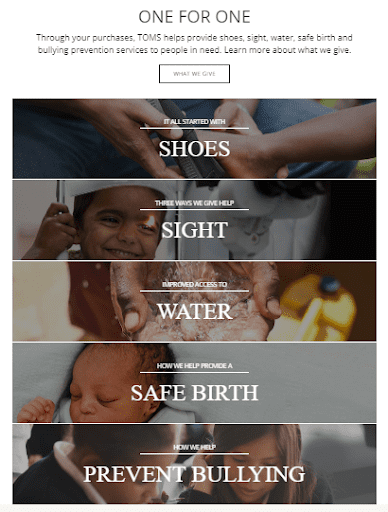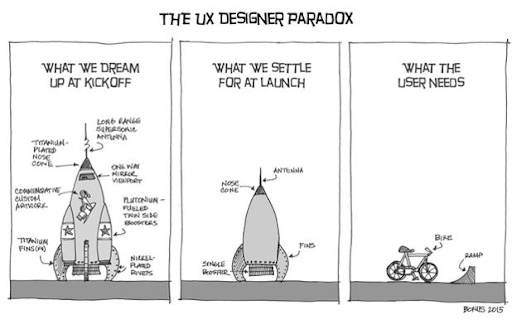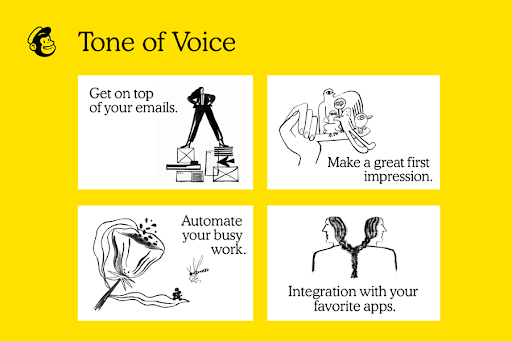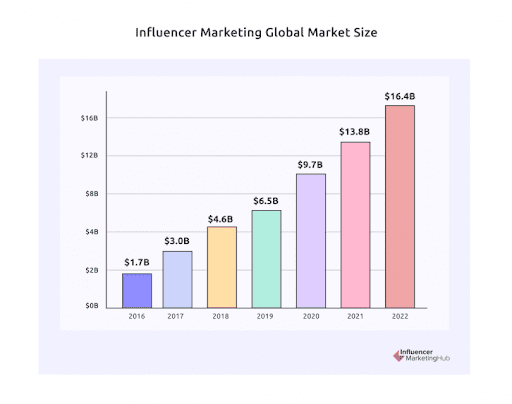
What do you think attracts customers to the brands? Is it just the products? Services? Discounts? Marketing?
These are, of course, the major players, but they are just a part of a bigger team: Brand experience.
The world has moved on from flashy marketing, making companies focus their game on creating trust and a lasting impression on prospects and customers.
The fact that 46% of customers are willing to pay more to brands they trust or CAN trust shows the overbearing influence that customer experience and brand image have on customer loyalty.
That’s where the brand experience comes in. It encompasses everything a brand does to evoke customer emotions, sensations, and behavioral responses.
From Apple with the stores, product packaging, and ads to Netflix with its marketing tactics like hosting a virtual fashion show for its shows like “The Queen’s Gambit“, several brand experiences are going off the charts, to win the customers’ hearts.
What’s more, according to a study by data analytics company Millward Brown:
“Brands that are meaningful, different, and salient derive three times more of their sales volume from the strength of the brand, as opposed to factors like availability and promotions. Furthermore, they command a price that is 14 percent higher, and their growth in value share is, on average, six percentage points higher than brands that are low on meaning, difference, and salience.”
Looking at this scenario, is your interest at its peak?
Hint: The correct answer is yes.
Then, let’s take it all the way.
What Is Brand Experience?
Brand experience is the emotional and lasting impression a brand leaves on its customers upon interaction. In a way, it is experiential marketing or, simply, brand experience marketing.
It consists of customers’ reactions, thoughts, and perceptions toward brands’ direct or indirect marketing efforts such as new product packaging and launches, ad campaigns, or loyalty programs.
Brand experience combines user experience, customer experience, and everything in between.
Why Does Brand Experience Matter?
Brand experience has a significant impact on different aspects of a business. Here’s how a positive brand experience and image benefit businesses.
Off the Charts Engagement
Customer experience takes care of conversions, lead generation, and similar stuff, but brand experience drives engagement.
You want your customers to be hooked to your BRAND and not just engage with your products.
If the engagement is limited to products/services, you won’t be able to offer an immersive brand experience or become a more significant part of their life.
Take Starbucks, for example. Of course, a cup of Starbucks Frappuccino is a great way to start your day, but so is coffee from any other cafe.
So, what’s the difference? – The experience of having that coffee in a Starbucks cup that’s worthy of an Instagram story.
Their brand experience encourages face-to-face interactions, live events, and close interactions that build a relationship between a brand and its customers.
Another good brand experience example is Coke’s “Share a Coke” campaign, where they launched soft drink bottles with various names and asked customers to share the pictures of their drinks with the #ShareACoke.
CASE STUDY: INMAN
InMan is a leading real-estate news source catering to agents and brokers. The platform wanted to spread awareness about its Real Estate Connect San Francisco conference and boost engagement.
Using feedback software Qualaroo’s survey NudgeTM with branching logic helped them understand what type of content their visitors are interested in to engage them and spread awareness about the event.
Evoke Empathy
If you create your brand experience strategy solely on the quantitative customer insights, you might treat them as a number. But if you also take in the qualitative insights, you’ll see the people behind the numbers.
Strategies with such dynamic insights enable you to create holistic user and customer experiences. The positive effects of this ripple down to your overall brand experience.
Let’s get into details. Here are a few more ways to build customer loyalty and promote empathy in customers:
- You can create personalized marketing strategies based on customers’ online behavior, preferences, and lifestyle. For example, your high-value clients will have a different lifestyle than low-paying customers. So, you can launch marketing campaigns catering to both customer segments.
- Social marketing is another experience branding method that helps your customers connect more personally with your brand. Brands create campaigns addressing specific social issues that resonate with the target audience.
For example, Toms gives away one pair of shoes to the needy for every purchase. Another example is Glossier, a beauty brand that pledged to fund $500,000 grant money to black-owned beauty startups and businesses.
- Empathy is a two-way street. If you want customers’ empathy, you have to show it to them too. Listening to the voice of your customers helps you understand their pain points and needs, which, in return, helps you empathize with them.
For example, McDonald’s ditched plastic straws in 2018 due to a customer-led petition with over half a million signatures. The initiative struck a chord with the customers and cemented their trust and loyalty to the brand.
CASE STUDY: AWA DIGITAL
AWA is a specialist agency that helps its clients grow their online sales. AWA was approached by Canon, a leading consumer electronics company, to improve its product demand across different locations.
Instead of running split tests for months to understand Canon’s customers and their preferences, AWA chose a shortcut and leveraged surveys to ask the customers directly.
AWA found out that some customers had reservations about spending a lot of money on a camera during their research. In other regions, brand authenticity and authority were a bigger concern.
With this, AWA personalized and optimized messaging elements for different geographies to suit diverse customer segments.
The result?
Canon generated an ROI of 700%!
Produce Trust in Customers
Did you know that 94% of shoppers are loyal to brands that support transparency? Customers’ trust is hard to achieve but plays a significant role in improving brand image and building brand experiences.
There are other ways to procure your customers ‘ trust besides using customer trust badges such as testimonials, customer reviews, and GDPR compliance.
Supporting the causes customers believe in builds their trust in your brand. Trust has to do with every customer’s interaction with your brand in their customer journey.
From positive customer support interaction to comments addressed under your social media posts and campaigns you launch, these are the touchpoints to build customers’ trust.
Know-How Your Customers Feel
Besides putting the finger on your customers’ pain points, you must also understand their feelings. When you know how your products/services make them feel, i.e., if they are satisfied or unsatisfied, you can take their contextual feedback to improve on those fronts.
The best way is to ask your customers, and you can do that using online pop-up surveys like these:
- Net Promoter Score survey gauges customer loyalty, i.e., if customers are satisfied enough with your brand to recommend it to others.
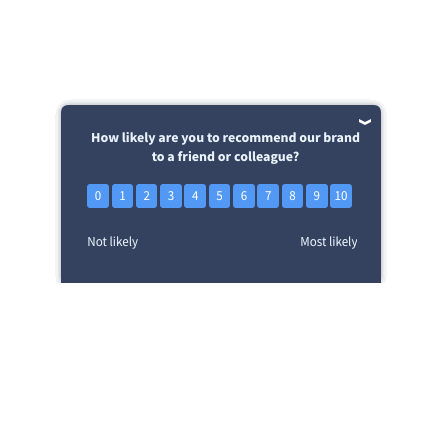
- Customer Satisfaction survey that helps you understand if customers are happy with your products/services.

- Customer Effort Score survey with which you can understand how easy or difficult it is for customers to use your product, avail of your services, or achieve a goal with your product/service.
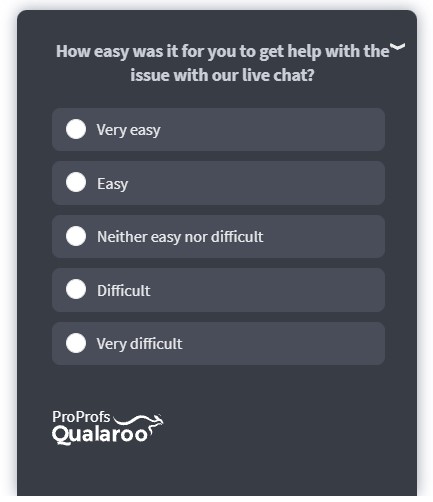
Using survey feedback tools like Qualaroo, you can use these one-question surveys to follow up with in-context open-ended questions to understand the reasons behind customers’ responses.
You can also leverage Sentiment Analysis technology to analyze the responses automatically and understand what emotions the written feedback represents.
With this feature, you can see the most-used words in the feedback, what emotions they represent, and get an overall emotional score.

You also need to streamline your customer data, for which you can use CRM tools like BIGContacts.
CASE STUDY: UDEMY
Since Udemy is an online learning platform offering online courses around the globe, they introduced auto-captioning on their videos to make these accessible to all users speaking different languages.
Auto-captioning is a product of machine learning and is prone to mistakes. Udemy decided to ask the users directly while they were active on their course to understand how this feature performed.
With Qualaroo’s surveys, they asked for the users’ feedback and were able to fix what needed fixing.
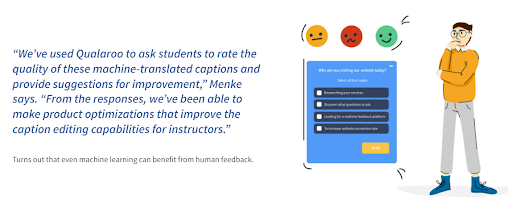
Elements You Need for a Flawless Brand Experience
As you read in the brand experience definition, BX is not a sole component; it combines everything a brand does, has, and offers. The elements in question are:
User Experience (UX)
User experience is the sum of users’ interaction with a brand’s products/services. It focuses on the end-users who will use a particular product or service.
The quality of your UX is set by how well you have mapped out your user journey and how satisfied customers are at every touch point.
For example, you can check if your website is easy to navigate, your product is easy to use without a steep learning curve or bugs, etc. You must ensure that every interaction your users have with you is positive.
Now, of course, you’ll require a little help from your customers to identify the problem areas in your UX to fix them. And what better way than to ask them directly using surveys.
You can conduct user experience surveys like User Effort Score, Software Usability Score surveys, etc., to get insights into your users’ behavior, preferences, and experience with your products/services.
Customer Experience (CX)
- CX is a holistic view of customers’ journey, including UX. It aims to fill the empathy gaps that UX may have left. In a way, customer experience IS the brand for customers. Here are a few elements of CX and how they affect it:
- Marketing
Marketing is a huge part of customer experience and, naturally, brand experiences, such as online on social media or offline, such as real-life events, billboards, and partnerships with other brands.
How you promote your brand and not just your products/services reflects on your brand image. It would be best to focus on personalized marketing to add to your CX.
For example, in the case of E-Commerce businesses, you can show personalized product recommendations on social media.
You need to ensure you know the correct information about your ideal customer personas to create marketing campaigns that they can resonate with. The data from your user research surveys conducted for your UX will also come in handy.
- Onboarding
Customer onboarding is one of the most crucial touchpoints in the customer journey. This is where your product users truly interact with your product for the first time.
You can use in-app messaging to help your customers navigate your product, highlight the most valuable features, and how to use them. You can also personalize the whole process to enhance the overall customer experience.
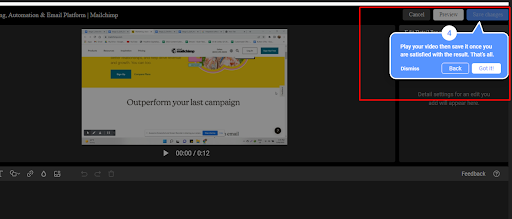
Another element that can make or break your brand experience is users’ experience with your product. How well your product performs will determine customer satisfaction and the quality of customer experience.
Product experience is direct (using the actual product) and indirect (product presented virtually or through an advertisement). And so, you have to ensure the indirect interaction is as successful as the direct one.
You can opt for an agile process for your products and make the iterations that customers suggest. You can use surveys to ask customers about their in-product experience and if they have suggestions.
Surveys such as NPS, CSAT, SUS, and CES/UES surveys will help you explore improvement areas to offer your customers flawless products and a delightful brand experience.
- Loyalty Program
Did you know 87% of customers want brands to have loyalty programs? Companies introduce these programs to reward and retain their loyal customers.
An extensive and inclusive loyalty program also adds to your CX and BX. So, if you don’t have one already, it would be best to strategize one that’s ideal for your customers.
- Customer Support
Business is not just about making your target audience aware of your products and getting them to purchase.
If you want to offer the best customer experience, you need to ensure their needs are taken care of even after the purchase. A good customer support system ensures that your customers have access to all the help they need regarding issues and queries.
You can leverage tools such as live chat to automate customer support so that your support representatives can take care of more serious customer tickets.
Besides this, you can also set up a knowledge base or a help desk for your customers to access information related to your product on the go. They won’t have to contact your support for common queries this way.
Brand Awareness
Brand awareness is when customers know your brand’s values and products. They can recognize and associate with it in their everyday life, so they don’t think twice while purchasing.
Besides experiential marketing, social media promotion is a game-changer that can help you reach a wider audience. It also places your company into your customers’ everyday lives since you can interact with them on their feed.
Brand Voice
Having a distinct brand voice adds character to your brand’s identity. It is how a brand continues to convey its messaging to the customers, regardless of the communication platform.
Your brand voice could be formal, depending on your offering, or informal like Mailchimp’s.
The marketing automation platform uses conversational voice with a sprinkle of dry humor.
FUN FACT
Did you know that SIEGEL+GALE, a brand strategy and design company, has a trademark for ‘Brand Voice’ as the company originated the term?
Brand Image
Brand image is intertwined with brand experience. If the experience is fantastic, it will positively impact the brand image, attracting more prospects. The way customers feel about your brand is how they will see it.
So, if you focus on delivering delightful experiences, you’ll automatically create a positive brand image.
Brand Design
Brand experience design is just as important as your brand’s tone of voice. Everything adds to how customers perceive your brand, from your brand logo to your website design and social media profile aesthetics.
In the podcast ‘The Future of Brand Experience,’ Howard Belk, Co-Chief Creative Officer at SIEGEL+GALE, narrates his experience of working with their client Hewlett-Packard on their unmistakable logo:

In the podcast, Belk mentions how simplicity is the way forward for brands in design.
Although you can tell the differences between these elements, you can’t have one without another. There is no brand experience vs. customer experience or any element, for that matter.
Everything from brand image, awareness, and user experience to customer experience all make up the brand experience as customers experience a brand as a whole.
How to Build a Brand Experience Strategy?
You don’t want to create JUST strategies; you want to create delightful experiences that paint the best version of your brand. So, how do you do that?
Here are a few legit tactics to design a brand experience strategy tailored to your business and target audience.
Start by Collecting Customer Feedback and Data
A great brand experience starts with offering what customers relate to and want. There are different ways to get to know your customers. For example:
→ Customer interviews.
→ Tracking visitor behavior on websites using tools like SessionCam and heatmaps.
→ Offline and online surveys.
→ Support call transcripts.
→ Reviews on social media and customer review websites, etc.
Learn more about each way to collect customer data in our detailed guide on the voice of the customer.
You’ll have deep insights into your target audience’s behavior, preferences, demographics, expectations, and more with customer data.
You can then use this information to design your experiences. For instance, say, a portion of your target audience comes from a geographic location where the literacy rate is relatively low. It may be your customers’ big concern, and they empathize with the cause.
Designing a marketing campaign that gives away a portion of your proceeds from that region for the cause will naturally make your customers empathize with your brand.
It’ll make your customers see your brand as a part of their society rather than just a company that sells products.
Here’s a real-life example:
McDonald’s stopped using plastic straws and switched to paper straws after customers started a petition to stop using plastic straws as they disturb aquatic life.
Looking at the customer feedback will also help you identify gaps between customer expectations and your actual experience.
You can analyze your social media interactions and reviews, feedback collected on website pop-up surveys, and interaction with your support service to identify the problem areas. Doing so will work as a foundation for your brand experience strategy.
Prioritize Areas of Improvement
With the feedback data you get, you can perform deep customer feedback analysis to identify priority areas for improvement. But why?
You may find multiple areas that need redesigning or improvement in your customer journey. It could be social media interactions, the website’s interface, certain product features, etc.
You need one point to start and not focus on all problems at once.
For example, if you see a high bounce rate on your website that hinders your lead generation, you can use a feedback survey tool like Qualaroo to launch exit-intent surveys. It’ll help you understand why customers leave your website without completing a goal.
Help Customers Empathize Using Storytelling
Do you want to limit your brand as a product-selling company or be seen beyond that?
If your answer is the latter, storytelling will help your customers see your brand as a part of society and not just a corporation.
Tell your brand’s story (the vision, what it stands for, and more) in every messaging and platform. From your articles, newsletters, advertisement commercials, product and landing pages, and marketing campaigns to your social media feed, tie everything back to your story.
For example, Nike creates advertisements that have little to do with the products themselves but focuses more on the people, the actual customers. The narration represents what the brand focuses on – its customers.
Make Offline Interactions Memorable
A flawless brand experience is a combination of online and offline experiences. You can improve the online experience by interacting with customers on social media by sharing tagged images and videos, offering incredible online chat support, creating a user-friendly website, etc.
As for the offline interactions, you need to consider the aesthetics of your stores (if you have a brick-and-mortar model), event campaigns such as workshops, seminars, product launches, billboard advertisements, etc.
For example, Apple has stores that go for a more simplistic and sophisticated approach with all white walls and wide-open spaces visible from the outside.
They have a distinct impression on customers that helps them easily spot the stores.
Another example is from the beauty brand Rare Beauty. It organizes events that focus on the mental and physical health of the customers.
It promotes self-care and aims to dismantle the stigmas associated with mental health. The products from the brand are part of the events, but they are not the center of attention.
Take Personalization a Step Further
Every second company is personalizing its services and products; the only difference is the degree of personalization.
For example, if you interact with an ad on Instagram for cargo pants, it will keep showing you ads for such products.
On the other hand, Spotify creates personalized playlists for users based on their most-played artists and genres of music. But the personalization doesn’t just stop here.
It goes even further with its ‘Spotify Wrapped’, where it sends a highly personalized list of most-listened songs, artists, and genres to each user. It even shows the frequency and minutes spent on the most-played songs.
So, it’s not just about personalizing the experience anymore; it’s about personalizing the experience even further to turn prospects into loyal customers. Again, to achieve this, you need to understand the user behavior and overall experience.
Leverage Popular Culture
Did you know that almost 28% of the world’s most successful companies like Burger King, Coca-Cola, and Nike have featured pop culture references in their marketing campaigns at least once?
So, if it’s something your business can venture into and profit from, you can find a way to ride the tide of pop culture. It’ll boost not just your sales but help offer a dynamic customer experience.
For example, a sports equipment company, REI, launched its Zombie Survival Kit infographic when the Walking Dead TV show saw the highest peak in popularity. The company boosted its customer engagement without even using the show’s name, which also helped them avoid licensing fees.
Get on the Influencer Marketing Bandwagon
Influencer marketing is on the rise and has become more popular than ever before. In 2021, the global market for it reached $13.8 billion.
Many industry giants such as Motorola, Pepsi, and Adidas use this marketing strategy to reach more audiences. This type of marketing works because customers believe reviews from other people over flashy marketing.
The products/services are presented to the target audience with influencers they trust and look up to. So, if you don’t have such a marketing strategy in place, it’s never too late.
Learn From the Best: Companies With Impactful Brand Experience Examples
Since you already know by now how to create a flawless brand customer experience strategy, let’s look at some good brand experience examples you can inspire from and follow.
Vans’ House of Vans
“House of Vans” is an excellent marketing initiative by Vans, a global shoe retailer. The campaign aimed to support the community of skateboarders and created events to bring people with similar passions closer. The events took place in Chicago, London, Brooklyn, and New York.
Another genius marketing stroke of experience branding from Vans is its skateboarding campaign for women on International women’s day in 2019.
Ben & Jerry
This ice-cream chain partnered with Colin Kaepernick to create a full-time ice-cream flavor, “Change the Whirled,” in 2020.
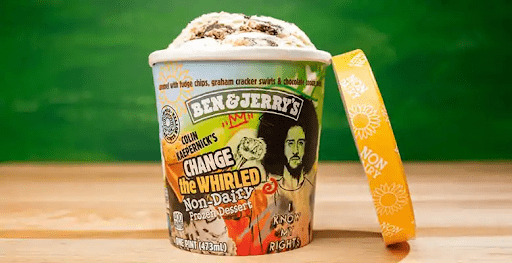
The brand has been vocal about social justice in the past, so they teamed up with Kaepernick to donate a portion of their proceeds to his organization “Know Your Rights Camp” (KYRC). The organization aims to educate and empower black and brown youth.
Netflix’s
Netflix has become synonymous with one enjoying their laid back time. The brand is known for its impeccable experiential marketing, but that’s not all the company does now.
Besides the fake kidnapping of 100 top Money Heist fans, Netflix also ventured into the ‘Insperience’ approach. As the world was pushed to go digital during and after the pandemic, brands also had to move their marketing strategies online.
In partnership with The Brooklyn Museum, Netflix organized the “Royal Virtual Costume Exhibit.” It was an interactive tour showcasing costumes from Netflix’s popular shows like “The Queen’s Gambit” and “The Crown: Season 4.”
Questions to Gauge Your Brand Experience
Remember how we discussed using customer feedback and data to perfect your brand customer experience?
Let’s talk more about that.
Finding the best way to collect customer insights can seem daunting at first, and understandably so. It isn’t easy to find the right questions to ask the right people.
But, it won’t be that way for you.
You can ask your customers these survey questions throughout their journey to get critical insights and design an immersive brand experience.
Questions to Ask Your Prospects:
- Is there anything on this site that doesn’t work the way you expected it to?
- Have you heard of our products/services? If so, how did you come across our brand?
- What are your biggest pain points with the current market offerings?
- What have you heard (positive and negative) about our company?
- If you had to describe our company in three words, what would they be?
- Please explain your first impression upon interacting with our company for the first time.
- When you think of [product name], which brand comes to mind?
- What problem/s are you trying to solve?
- Is our pricing clear?
Questions to Ask Post-Purchase:
- Was there anything about this checkout process that we should improve?
- Can you please explain your purchasing experience with us?
- How will you describe your previous experience with us?
Questions to Ask at the Onboarding Stage:
- Was the onboarding process helpful?
- How easy was it for you to use the tool the first time?
- Was anything critical to your success we didn’t cover during our onboarding process?
- How would you rate your level of knowledge of what our product can do?
- Do you think our product will help you achieve the goals you want to achieve?
Questions to Ask for Product Experience:
- How can we make [Product] easier to use?
- If you could change one thing about [Product], what would it be?
- On a scale of 1 to 10, how would you rate the ease of use of [Product]?
Questions to Gauge Customer Satisfaction and Loyalty:
- How would you feel if you could no longer use our product/service?
- Are you satisfied with the quality of our products?
- On a scale of 0-10, how likely are you to recommend our brand to your friends and family?
General Brand Experience Questions:
- How much would you expect to pay for [Product]?
- Why do you prefer to buy from us?
- Is our brand’s purpose evident to you?
- Which values do you think [Brand name] best represents?
- Which brand of [Product] do you prefer?
- How will you describe our brand to a friend?
- If you were in charge of this brand/product/service, what’s the first thing you’ll like to change?
Brand Experience: The Road Ahead
Companies have been nailing their brand experience marketing using the four Ps of the brand experience: perception, participation, personalization, and prioritization.
But of course, some new trends or players will play a huge role in defining the success of your brand experience strategy.
In the podcast you read about above, the guest Howard Belk shared his expert view on how the brands approach the BX after the pandemic. He shares that the brands are leaning more towards simplicity in design.
Apart from this, after witnessing how companies design experiences catering to both online and offline audiences, it’s safe to say that the future is hybrid.
Companies are aiming for a borderless brand experience by leveraging technological advances to perfect their ability to offer the best brand experiences virtually (Netflix’s virtual fashion show, for example).
So, you should focus on experience and insperience to promote brand love and improve customer experience.
Not to mention how listening to your customers and understanding their overall experience will help you fill the gaps to create experiences that customers will call their “favorite brand experience.”
FREE. All Features. FOREVER!
Try our Forever FREE account with all premium features!

